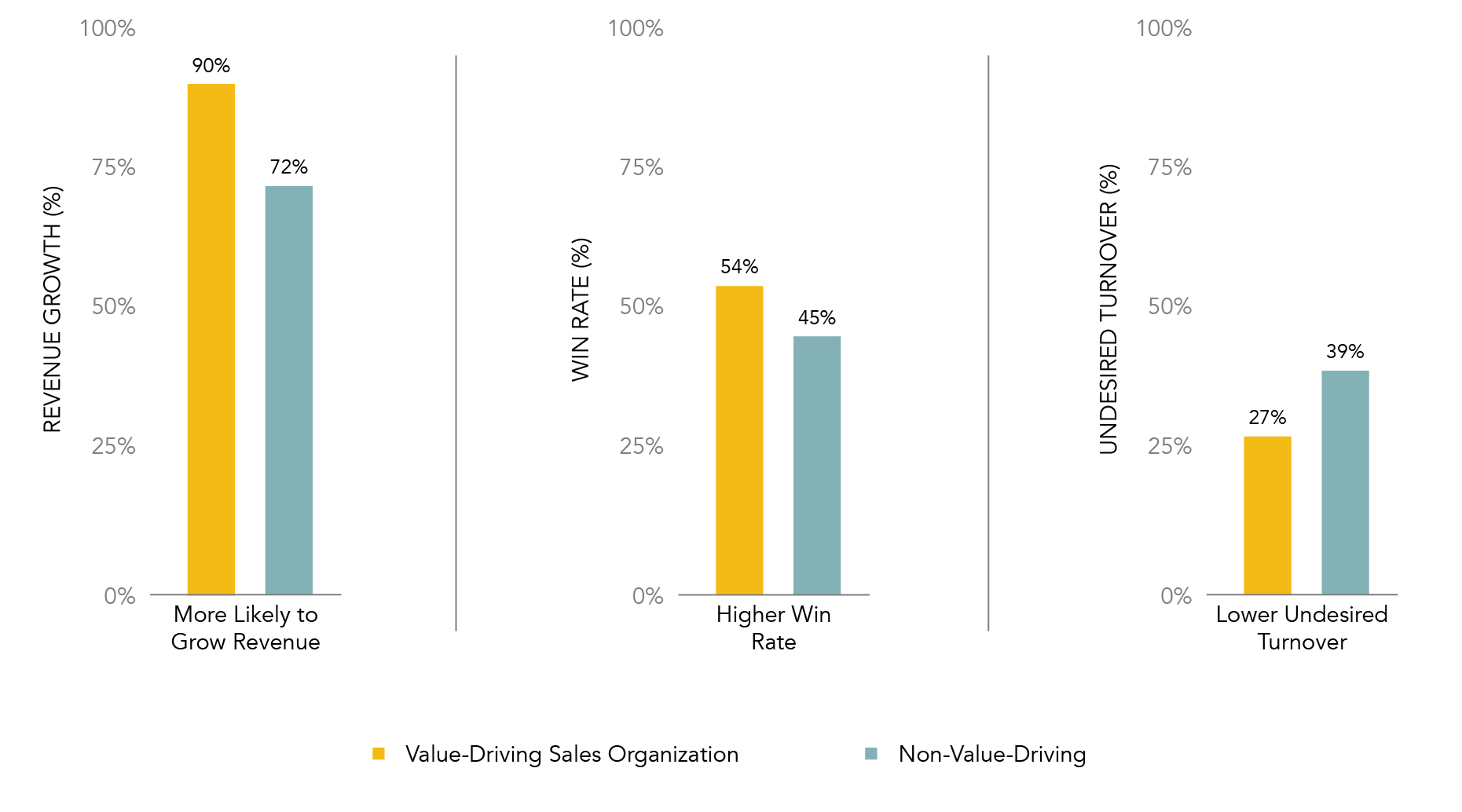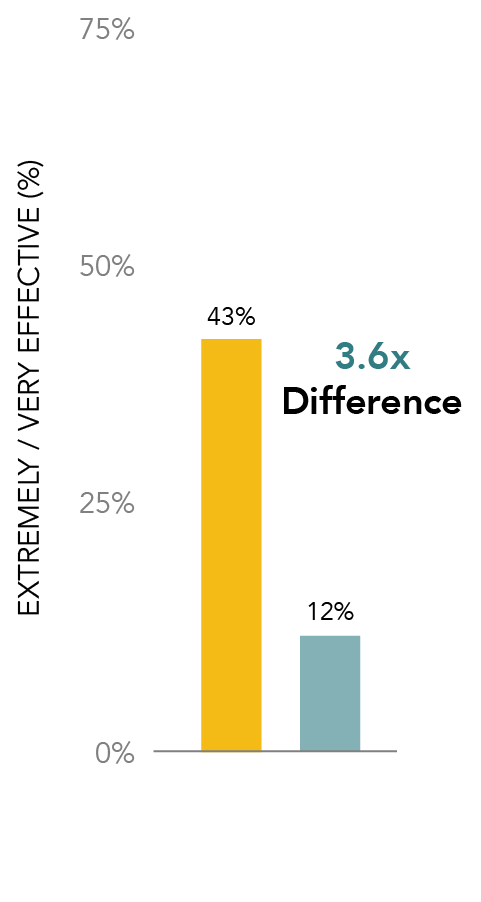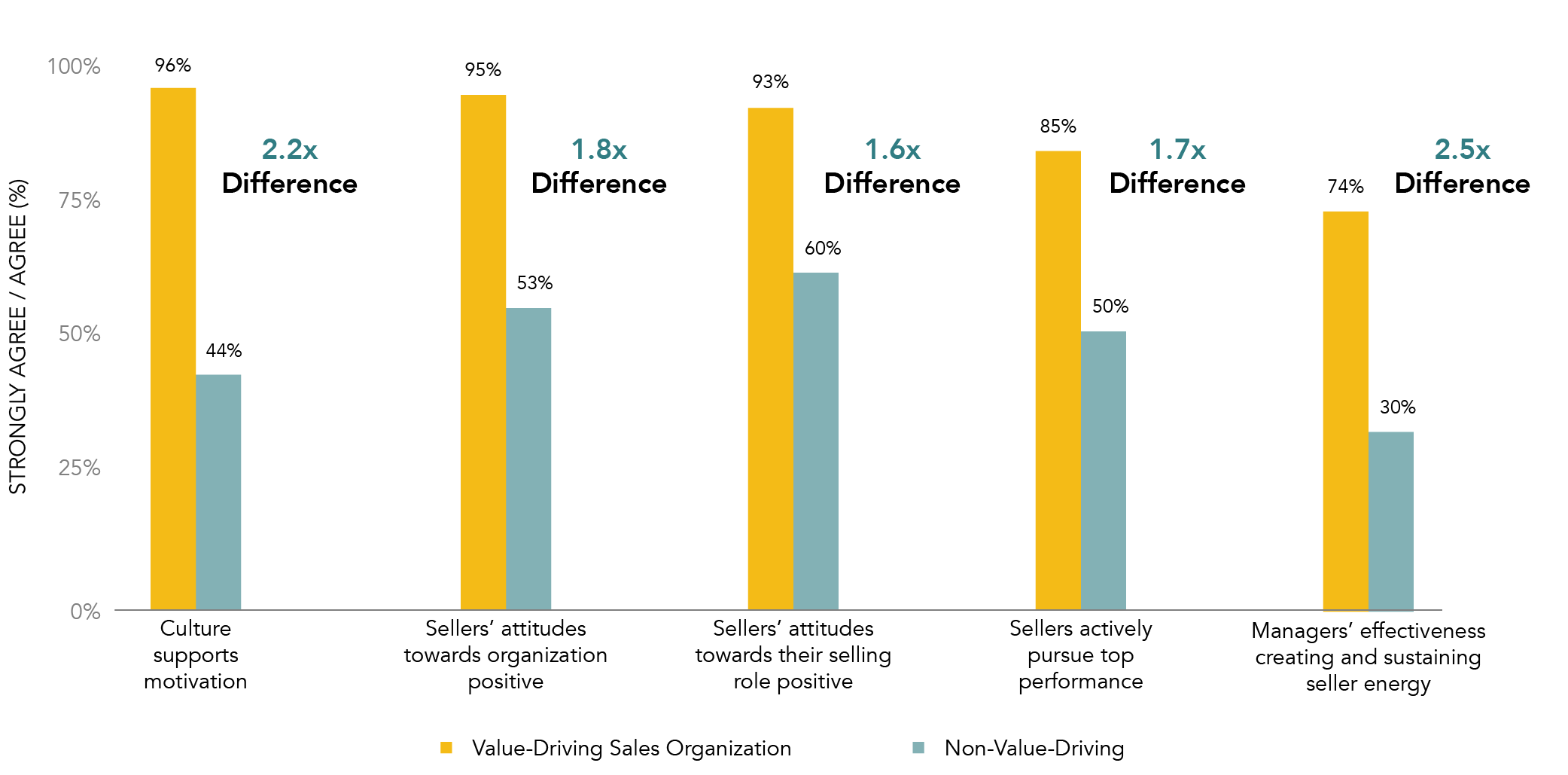What Is Value-Based Selling?
Value-based selling is a sales approach where sellers maximize buyer value by redefining reality, understanding and shaping buyer need, crafting compelling solutions to address need, communicating maximum impact, and driving change with ideas that matter. Value-based selling encompasses both consultative selling and advanced consultative/insight selling.
The mantra “sell value” echoes throughout many sales organizations. But is this approach truly effective? Do sales teams that consistently drive buyer value achieve better results? And if so, what's the tangible return on investment? What are the actual benefits of value-based selling?
Most leaders insist they only have room for a few priorities and need to know the return they’ll see on any investment they make. Understanding the impact of value-based selling is crucial.
Our research at the RAIN Group Center for Sales Research consistently highlights the role of value in successful sales strategies:
- Sales winners are 3x more likely to bring new ideas and perspectives to buyers compared to second-place finishers (this is also the #1 factor most separating the two groups)
- 81% of Top-Performing Sales Organizations agree they focus on driving maximum value for buyers (compared to only 61% of The Rest)
- Top-Performing Sellers are 60% more likely to excel at presenting the overall value case persuasively and 63% more likely to excel at making and communicating strong ROI and financial cases for buyers
Buyers report that a seller’s "focus on the value they can deliver" is the #1 most influential factor in their purchase decision, with 96% finding it influential.
This research underscores the importance of value-based selling.
In this article, we’ll explore how both individuals and organizations can adopt a value-based sales approach and what they stand to gain from doing so.
Research download: The Value-Driving Difference >>
6 Tips for Value-Based Selling
1. Rethink Your Value Proposition
Your value proposition helps articulate the value you deliver. It seems obvious, but sales approaches like solution selling place emphasis on the power of your solution to win over the buyer and close deals.
Your value proposition is more than your solution: it’s the collection of reasons why your buyers buy and why they choose the sellers they do.
The reasons why buyers buy fall into three categories:
- Resonate: Buyers have to want and need what you’re selling
- Differentiate: Buyers have to see why you stand out from other available options
- Substantiate: Buyers have to believe you’ll meet your promises and deliver desired results
When your value proposition successfully covers these three areas, you convince buyers that they need your solution, you’re the best option, and they believe you’ll achieve results.
2. Create Value in the Selling Process
With value-based selling, you must be prepared to guide your buyer through the buying process and make it as easy for them as possible.
Think about everything that goes into your average sales cycle, and how your selling process aligns with the buying process. When you think buying first and selling second, you help buyers better understand their needs and uncover value by collaborating with them.
Do you know where your buyers are in the buying process at any given time? Can you remove any common communication hurdles, mitigate risk, or make less work for the buyer?
It’s also worth examining stage-by-stage trends in your sales process. Are there places you most often lose sales? If so, it’s worth examining how you can better sync up with what the buyer wants and drive urgency with them.
Get a blueprint for creating value across the buying and selling process. >>
3. Research Your Buyer
In many cases, building value starts even before you start prospecting. With buyer research, you can begin to understand their needs and why they might be interested in connecting with you.
Do this as early as possible, and you’ll be less likely to waste your time on outreach that falls short. If you’re not sure where to start:
- Review your CRM information, and determine if/when you’ve engaged with them before
- Explore their website for news, press releases, original content, and to identify their leadership team
- Review socials for the company and specific contacts
- Use Google News to track down any other updates from their company or industry
In addition, stay informed on the trends and issues facing your buyers’ industries by subscribing to relevant information sources and joining industry groups.
Learn how to use AI to help with buyer research. >>
4. Share New Ideas
It can be difficult to go into a buyer conversation when they’re stuck in their comfort zone, certain of what they want. As a seller, it’s your job to open your buyers’ minds to new possibilities. With value-based selling, you want to help them to make the best decision possible, which often involves them making different decisions.
Buyers may have access to more information than ever, but our research shows that sellers who drive value for buyers in the form of insights and ideas are more likely to succeed.
Sellers who win are skilled at guiding buyers out of their comfort zones and delivering insights that encourage them to think differently. This can be done with a balance between asking strong questions and sharing ideas.
When you share new ideas well, you become an indispensable resource for your buyer. However, this doesn’t happen in a vacuum—it’s a result of understanding your buyers’ needs, listening to them, and collaborating with them.
5. Collaborate with the Buyer
Value-based selling isn't about pushing your solution onto the buyer. Instead, it's about working together to uncover needs, explore possibilities, and create solutions. Collaboration is key to building trust and demonstrating your commitment to the buyer's success.
One powerful way to collaborate is by asking insightful questions. These questions should challenge the buyer's thinking, uncover hidden needs, and spark new ideas. For example:
- Ask "Why?" to understand the reasoning behind their strategies or choices. This can reveal opportunities to provide valuable insights.
- Use "How?" questions to help buyers think through implementation. This shows you're invested in their long-term success, not just making a sale.
- Inquire about past attempts that didn't work. This gives you a chance to offer fresh perspectives or introduce new solutions they may not have considered.
- Present alternatives by asking, "Have you considered A, B, C?" This can broaden their view of possible solutions.
- Challenge assumptions respectfully with questions like, "What if I suggested you might have under-invested in the past?" This can open discussions about more effective approaches.
- Explore possibilities by asking what they think is achievable. Then, you can expand their vision if needed.
The goal of these questions isn't to interrogate, but to think critically together. This collaborative approach helps you understand the buyer's perspective, challenges their assumptions constructively, and positions you as a valuable partner in their success.
Don't stop there. Click here to download 50 powerful sales questions. >>
6. Demonstrate Impact
In value-based selling, it's crucial to demonstrate the impact your solution can have on the buyer's business. Making a compelling impact case requires several key elements:
- Calculate and communicate business impact: Translate the benefits of your solution into tangible financial outcomes. Develop a strong ROI case, but remember to involve the buyer in building it. This increases their buy-in and belief in the potential results.
- Address emotional impact: Don't overlook non-financial benefits like increased prestige, job satisfaction, or peace of mind. Highlight the opportunities your solution creates for individuals and the organization as a whole.
- Compare to alternatives: Clearly differentiate your solution from competitors. Show how your offering provides superior value, whether through better ROI, product quality, or service.
- Illustrate the cost of inaction: Help buyers understand what they might lose by not moving forward. This can create a sense of urgency and elevate your solution's priority.
- Leverage social proof: Share relevant case studies and success stories that demonstrate how you've helped similar clients overcome challenges or achieve goals. The more closely these examples match the buyer's situation, the more impactful they'll be.
- Make it tangible: Use visual aids like before-and-after tables or graphics to paint a clear picture of the positive changes your solution will bring. This helps buyers envision the future state you're proposing.
A compelling case isn't improvised. It requires careful planning and should be tailored to each buyer's unique situation. By combining industry expertise with insights gained from your conversations with the buyer, you can create a powerful impact model that educates the buyer and demonstrates the full value of your solution.
Organizational Benefits of Value-Based Selling
As part of our Top-Performing Sales Organization research, we wanted to see just what kind of difference value makes.
We studied 472 sellers and executives globally at mid-size and large companies. We identified 16% of respondents as being Value-Driving Sales Organizations based on their value- and customer-focus orientation.
Value-Driving Sales Organizations outperform Non-Value-Driving Sales Organizations across a number of categories. Examining these two groups helped us uncover 10 key correlations that set Value-Driving Organizations apart from the rest.
10 Markers of Value-Based Organizations
- Revenue growth
- Higher win rates on proposed sales
- Lower undesired sales turnover
- Leadership prioritization of improving sales force effectiveness
- Customer-focused sales process
- Leadership investment in sales training
- Sellers with strong sales skill set
- Highly-motivated sellers
- Alignment of account and lead assignment
- Ability to capture maximum pricing and achieve better margins
1. Revenue Growth
Sales organizations with a value-driving focus are significantly more likely to grow revenue. In our research, we found 90% of Value-Driving Sales Organizations grow revenue year-over-year compared to only 72% of the organizations that are not value-driven.
2. Higher Win Rates
Likewise, Value-Driving Sales Organizations experience higher average win rates (52%) compared to the non-value driven organizations (45%).
3. Lower Undesired Sales Turnover
When sales organizations emphasize value, they retain more of their most productive sellers with an undesired turnover rate of 27%, compared to 39% for organizations that aren't value-focused. Given the high cost of turnover, investing in a sales team willing and able to create value for buyers becomes even more appealing.
 |
4.Better Priority Execution
We studied both leadership's prioritization of improving sales force effectiveness and leadership's ability to execute on priorities. Both correlate significantly to top sales performance.
88% of company leaders in Value-Driving Sales Organizations prioritize improving sales force effectiveness. Other organizations? Only 54% do.
We also asked company leaders, "When you set a priority, does the priority get done?" 85% of leaders in Value-Driving Sales Organizations answered yes, whereas only 49% of company leaders in Non-Value-Driving Sales Organizations agreed.
It's no surprise: the rigor and investment leadership allocates to sales performance makes a difference.
5. Stronger Process Orientation
In our experience, without a unifying framework for sales processes, sales methods, and strategic account processes, sellers are left to their own devices. Without structure, some sellers focus on value and others don't (not necessarily for dubious reasons, often they don't know how). When this happens, average results are the norm.
By definition, 100% of leaders in Value-Driving Sales Organizations say their sales process is customer-focused and maps to their buyers' buying processes. Only 38% of those in Non-Value-Driving Sales Organizations claim this is true about their process.
Additionally, 100% of sales leaders in Value-Driving Sales Organizations say their sales process is flexible to apply to their buyers' various roles and situations, whereas only 45% of respondents in Non-Value-Driving Sales Organizations say this is true about their sales process.
In other words, when buyers buy from a value-driving organization, they know it. The selling process is focused on buyers and customized to their unique situations.
Read: The 6 Essential B2B Sales Funnel Stages >>
6. Focus and Investment in Sales Training
Leaders at Value-Driving Sales Organizations not only prioritize developing sellers to be as valuable as possible to buyers, but also invest in it. And when sales leaders prioritize training, there's a significant rise in sales skills across the board.
|
Value-Driving Organizations Have More Effective Sales Training |
Value-Driving Organizations Have Greater Investment in Sales Training |
 |
 |
 |
|
7. Better Sales Skills
Across every skill area, Value-Driving Sales Organizations have significantly stronger sales skills—in some cases 3x stronger skills than Non-Value-Driving Sales Organizations. Given that we know Value-Driving Sales Organizations invest more heavily in their sales training, and that their training is rated more effective, it's no wonder they have higher win rates, revenue growth, and sales force retention.
8. Highly-Motivated Sales Forces
Sellers will tell you, "If I believe in what I'm selling, I can sell so much more of it." When sellers work at an organization they believe prioritizes driving customer value, and when their leaders prioritize helping sellers to create said value, seller motivation is drastically higher.
Certainly, sellers bring their own intrinsic motivation to their jobs. It's up to the organization, however, to tap into seller motivation at a high level and sustain it. The extraordinary differences comparing Value-Driving Sales Organizations and Non-Value-Driving regarding sales motivation are stark.
|
Value-Driving Organizations and Motivation |
 |
9. Informed Account and Lead Assignment
By definition, Value-Driving Sales Organizations align their sales force structure with the way customers prefer to buy. This often means assigning leads and accounts not only based on territory, but also on buyer industry, company size, and need.
Indeed, Value-Driving Sales Organizations understand what their buyers are looking for and assign the people who are best suited to win and grow accounts. In fact, they're nearly 3x as likely as Non-Value-Drivers to be aligned with the way their customers prefer to buy.
Learn to build an effective sales territory plan. >>
10. Capturing Price
By definition, Value-Driving Sales Organizations focus on driving maximum value for their customers (100% compared to 59% of Non-Value-Driving Sales Organizations).They're also 2x more likely to agree their pricing strategy allows them to capture maximum prices in line with the value they provide. Our experience supports this. By focusing on customer value over price, companies maximize pricing and improve margins.
Adopting Value-Based Selling
Value-based selling makes a tremendous difference in a sales organization’s process, approach, and results. If you want to enjoy these results and join the 16% of Value-Driving Sales Organizations, you can start by:
- Making value a priority
- Aligning your structures and sales processes to be customer-centric and flexible
- Investing in sellers' abilities to be more skilled, knowledgeable, and valuable







